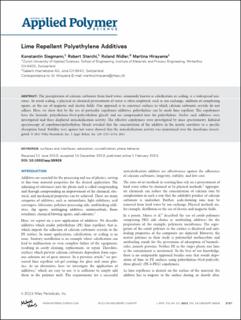Please use this identifier to cite or link to this item:
https://doi.org/10.21256/zhaw-4135Full metadata record
| DC Field | Value | Language |
|---|---|---|
| dc.contributor.author | Siegmann, Konstantin | - |
| dc.contributor.author | Sterchi, Robert | - |
| dc.contributor.author | Widler, Roland | - |
| dc.contributor.author | Hirayama, Martina | - |
| dc.date.accessioned | 2018-02-26T09:19:09Z | - |
| dc.date.available | 2018-02-26T09:19:09Z | - |
| dc.date.issued | 2013-02-01 | - |
| dc.identifier.issn | 1097-4628 | de_CH |
| dc.identifier.uri | https://digitalcollection.zhaw.ch/handle/11475/3047 | - |
| dc.description.abstract | The precipitation of calcium carbonate from hard water, commonly known as calcification or scaling, is a widespread nuisance. To avoid scaling, a physical or chemical pretreatment of water is often employed, such as ion exchange, addition of complexing agents, or the use of magnetic and electric fields. Our approach is to construct surfaces to which calcium carbonate crystals do not adhere. Here, we show that by the use of particular copolymer additives, polyethylene can be made lime repellent. The copolymers have the formula: polyethylene-block-poly(ethylene glycol) and are compounded into the polyethylene. Twelve such additives were investigated and three displayed anticalcification activity. The effective copolymers were investigated by mass spectrometry. Infrared spectroscopy of copolymer/polyethylene blends revealed that the concentration of the additive in the matrix correlates to a specific absorption band. Stability tests against hot water showed that the anticalcification activity was maintained over the timeframe investigated. | de_CH |
| dc.language.iso | en | de_CH |
| dc.publisher | Wiley | de_CH |
| dc.relation.ispartof | Journal of Applied Polymer Science | de_CH |
| dc.rights | Licence according to publishing contract | de_CH |
| dc.subject | Surfaces and interfaces | de_CH |
| dc.subject | Crystallization | de_CH |
| dc.subject | Adsorption | de_CH |
| dc.subject | Phase behavior | de_CH |
| dc.subject.ddc | 540: Chemie | de_CH |
| dc.title | Lime repellent polyethylene additives | de_CH |
| dc.type | Beitrag in wissenschaftlicher Zeitschrift | de_CH |
| dcterms.type | Text | de_CH |
| zhaw.departement | School of Engineering | de_CH |
| zhaw.organisationalunit | Institute of Materials and Process Engineering (IMPE) | de_CH |
| zhaw.publisher.place | New York | de_CH |
| dc.identifier.doi | 10.21256/zhaw-4135 | - |
| dc.identifier.doi | 10.1002/APP.38928 | de_CH |
| zhaw.funding.eu | No | de_CH |
| zhaw.issue | 5 | de_CH |
| zhaw.originated.zhaw | Yes | de_CH |
| zhaw.pages.end | 2734 | de_CH |
| zhaw.pages.start | 2727 | de_CH |
| zhaw.publication.status | publishedVersion | de_CH |
| zhaw.volume | 129 | de_CH |
| zhaw.publication.review | Peer review (Publikation) | de_CH |
| zhaw.webfeed | Polymere Beschichtungen | de_CH |
| Appears in collections: | Publikationen School of Engineering | |
Files in This Item:
| File | Description | Size | Format | |
|---|---|---|---|---|
| 2013_Siegmann_Lime Repellent Polyethylene Additives_Journal_of_Applied_Polymer_Science.pdf | 496.81 kB | Adobe PDF |  View/Open |
Show simple item record
Siegmann, K., Sterchi, R., Widler, R., & Hirayama, M. (2013). Lime repellent polyethylene additives. Journal of Applied Polymer Science, 129(5), 2727–2734. https://doi.org/10.21256/zhaw-4135
Siegmann, K. et al. (2013) ‘Lime repellent polyethylene additives’, Journal of Applied Polymer Science, 129(5), pp. 2727–2734. Available at: https://doi.org/10.21256/zhaw-4135.
K. Siegmann, R. Sterchi, R. Widler, and M. Hirayama, “Lime repellent polyethylene additives,” Journal of Applied Polymer Science, vol. 129, no. 5, pp. 2727–2734, Feb. 2013, doi: 10.21256/zhaw-4135.
SIEGMANN, Konstantin, Robert STERCHI, Roland WIDLER und Martina HIRAYAMA, 2013. Lime repellent polyethylene additives. Journal of Applied Polymer Science. 1 Februar 2013. Bd. 129, Nr. 5, S. 2727–2734. DOI 10.21256/zhaw-4135
Siegmann, Konstantin, Robert Sterchi, Roland Widler, and Martina Hirayama. 2013. “Lime Repellent Polyethylene Additives.” Journal of Applied Polymer Science 129 (5): 2727–34. https://doi.org/10.21256/zhaw-4135.
Siegmann, Konstantin, et al. “Lime Repellent Polyethylene Additives.” Journal of Applied Polymer Science, vol. 129, no. 5, Feb. 2013, pp. 2727–34, https://doi.org/10.21256/zhaw-4135.
Items in DSpace are protected by copyright, with all rights reserved, unless otherwise indicated.